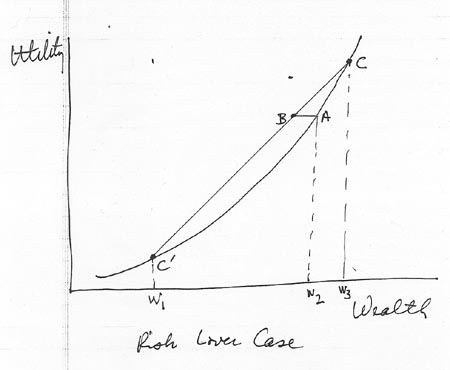Lecture 5 - 9/14/99
Income Effects from Rand Study
-
Income elasticity of demand 0.2 or less
-
These estimates hold technological change constant (also true for price
elasticities)
-
Income elasticities from aggregate, cross-country studies over 1.0
Aggregate Cross-Country Studies (pp. 608-10, Phelps)
-
Health expenditure per capita = -290 + 0.1 (per capita income)
-
(t=3.5) (t=14.3)
N=24 , elas.=1.35
-
Log (per capita spending) = -10.2 + 1.8[log(per capita
income)]
-
(t=10.0) (t=17.0)
N=24 , elas.=1.8
Demand for Health Insurance
-
Refer to Phelps, Chap. 10
-
Health insurance is one of many insurances--third party v. first party
insurance
-
Demand for health insurance related to demand for health care services
-
Like all other goods, demand for insurance depends on its "own" price
Concepts of Price of Insurance and Expected Loss
-
Expected loss: EL=(1-p)*0 + p*L
-
Expected loss=actuarial value of loss
-
Example: let p=..025, L=$8,000, then EL= .975*0+.025*8,000=$200
Risk Aversion Graph

Model of Demand for Insurance: Initial Assumptions
-
A1: Individual maximizes his/her utility
-
A2: Loss fixed at $* if in sick state
-
A3: Probability of loss fixed
-
A4: Individual chooses between two courses of action: (1) buy insurance
and thereby incur small certain loss in form of insurance premium or (2)
self-insure and thereby face a large loss if sick and large probability
of no loss
-
A5: Decreasing marginal utility of income (wealth)--same as risk aversion
-
Let W3 = $10,000 (if well and self-insure); W2 = $9,800 (if insure); W1
= $2,000 (if sick and self-insure); $200 is actuarial value of loss
-
At W3, U=100; at W2, U=99; at W1, U=20
-
Then EU= .025*20+.975*100=98. But U =99 >EU=98
Expected Utility Graph
-
Can find expected utility (EU) by drawing a straight line from end points
-
A-B represents the additional amount insurance company could extract from
the individual and make him as well off as self-insuring.
-
The more curvature the “certainty” curve has, the more risk averse the
individual is
Interpret the Cord from Expected Utility Graph
-
See why cord is a straight line. Given U(W1) and U(W3) fixed, expected
utility varies linearly
-
Example: say p=.05, then EU=.05*20+.95*100=96; if p=.1, EU=.1*20+.9*100=92;
if p=.15, EU=.15*20+.85*100=88. etc.
-
If increase p, EL also up and W3-W2 up--see W2*
-
If utility in the healthy state is increased, slope of cord becomes steeper
and closer to the certainty curve. To see this, make U(W3)=120 (instead
of 100)
-
Again, if have constant MU of wealth, certainty curve and cord coincide.
Then, there can be no demand for insurance
Risk Lover Graph

Risk Lover Case
-
In this case, MU of wealth increases with increased wealth
-
Certainty curve becomes convex to wealth (X) axis and cord on other side
of curve.
-
Line to cord represents amount willing to pay for opportunity to gamble
-
Friedman and Savage (1948)--people have risk loving (when poor) and risk
averse regions (when nonpoor)
Determinants of Demand for Insurance
-
Characteristics of service. More demand for service to be covered
if (1) probability of loss in mid-range, (2) possible expenditure loss
high, (3) price elasticity of demand for service is low
-
Adverse selection (expected use of service)
-
Loading
-
Tax subsidy (varies with marginal tax rate)